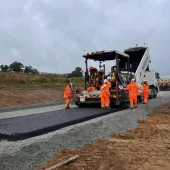ALARM survey 2021 released

Asphalt Industry Alliance says inconsistent roads funding leads to quick fixes rather than long-term solutions
MAINTAINING roads to target conditions is still out of reach for local authorities in England and Wales despite an increase in highway maintenance budgets, according to this year’s Annual Local Authority Road Maintenance (ALARM) survey.
The ALARM survey, published today (31 March) by the Asphalt Industry Alliance (AIA), shows that the legacy of inconsistent funding in England and Wales is still preventing highway engineers from being able to provide long-term, cost-effective maintenance improvements for local roads.
The 26th survey reports a 15% increase in highway maintenance budgets which were, in part, due to additional funding from central government, including the Pothole Fund in England, as well as supplementary pots to support changes as a result of COVID-19 needs and active travel ambitions. However, budgets reported are still lower than they were two years ago, and road conditions have yet to see any significant improvement.
According to the AIA, this up–down approach to funding results in wasteful patch and mend repairs as local authorities have a statutory duty to maintain the highway but do not have the scope or certainty of funding to implement more cost-effective, proactive repairs. This, says the Association, is borne out by the large increase in the number of potholes filled over the last 12 months in England and Wales, the equivalent of one being filled every 19 seconds.
Local authorities also report that, despite the increase in budgets, target road conditions still remain out of reach. They say that if they had enough funds to meet their own targets conditions across all road types, there could be an additional 14,400 miles of local roads in a good state of repair and another 2,000 fewer miles in need of urgent repair.
‘The last year has been like no other and the ‘hidden heroes’ responsible for maintaining our local roads should be proud of the role they played working throughout the pandemic to keep our key workers and emergency services moving, supermarket shelves stocked and vaccines distributed,’ said Rick Green, chair of the AIA.
‘While the extra funding in 2020/21 was welcomed, using it to repeatedly fill in potholes is essentially a failure as it does nothing to improve the resilience of the network. The average frequency of road surfacing is now once every 68 years and the bill to fix the backlog of maintenance work on our local roads in England and Wales remains in excess of £10 billion.
‘It is clear that a longer-term approach to local road funding is needed, similar to the five-year commitment made to the strategic road network in the two Roads Investment Strategy (RIS) periods, to allow local authority highway engineers to plan ahead and implement a more proactive, sustainable and cost-effective whole-life approach to maintaining the network.
‘This commitment is vital to the nation’s post-pandemic reset in which we will rely on our local road network to support recovery and underpin active travel and levelling-up goals.’
Commenting on this year’s ALARM report, Gareth Day, Hanson UK’s asphalt managing director, said: ‘We are proud to be a member of the Asphalt Industry Alliance (AIA) and support its call for a five-year approach for local road funding, in line with the commitment that has been made for motorways and major A roads through RIS.
‘The findings of the AIA’s 2021 ALARM survey demonstrate the impact that inconsistent funding is having on the condition of local roads and a longer-term approach will allow highway engineers to plan ahead for the benefit of all road users.
‘Demand for asphalt was 8.6%lower in 2020 than in 2019, so a five-year commitment from central government will provide the asphalt industry with the confidence needed to continue to invest and develop new products to enhance sustainability and reduce carbon emissions.’
Paul Fleetham, managing director of Tarmac Contracting, commented: ‘Well-maintained local roads underpin our communities and economies, support improved social outcomes, whilst also being central to encouraging people to take greener forms of transport – and so getting these back up to a good standard is critical to ‘building back better’.
‘The increase in highways maintenance budgets is a positive step in the right direction, however, it’s essential that this uptick in funding is met with longer-term commitments which will allow local authorities to deliver the most effective asset-management approach to essential road maintenance programmes.
‘Enabling a properly funded, proactive approach to our highways will deliver the improvements that are needed to ensure that the local road network – which accounts for 98% of our highways – is no longer treated as a second-class asset.’
ALARM Survey 2021 – Key Facts:
- Average highway maintenance budgets up 15% – to £23.8 million per authority in England and Wales (£20.7 million, 2020; £24.5 million, 2019).
- £752.6 million – carriageway maintenance budget shortfall in 2020/21 (£4.6 million per authority in England; £4.5 million in London; and £3.8 million in Wales).
- £10.24 billion – estimated one-time cost to get roads back into a reasonable, steady state (£77.2 million per authority in England; £27.6 million in London; and £28.9 million in Wales).
- 10 years – estimated time it would take to clear the maintenance backlog if local authorities had the funding and resources available to do the work.
- 68 years – average time before a road is resurfaced (83 years in England; 31 years in London; and 46 years in Wales).
- A pothole is filled the equivalent of every 19 seconds in England and Wales.
- £15.0 million – total cost of dealing with compensation claims, equivalent to £73.14 for each mile of the local road network.
The full ALARM survey 2021 can be downloaded below or by visiting: www.asphaltuk.org









